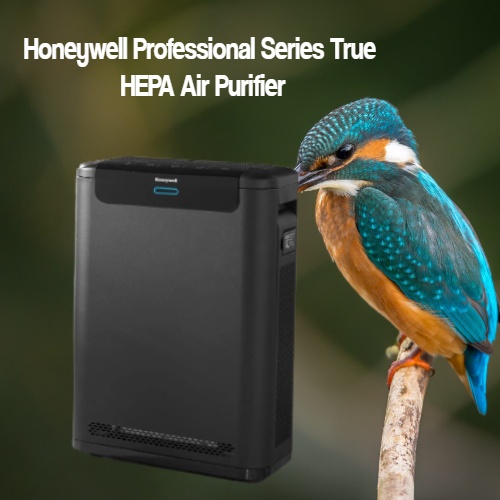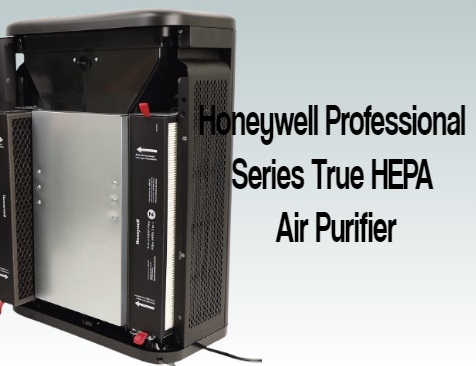Yes. Honeywell says it does, especially the Honeywell Professional Series True HEPA Air Purifier, HPA600B. My research on whether it destroys mold spores also confirms this. In addition to getting rid of mold spores and allergies, it eliminates potentially harmful volatile organic compounds (VOCs), such as formaldehyde., and ultrafine dust.
This air purifier features their most powerful air cleaning technology to date. An LED Air Quality Indicator provides real-time input from an indoor air quality monitor, which is driven by particle and volatile organic compound (VOC) sensors and continuously monitors the air in the room. The data provided by the LED Air Quality Indicator is easy to understand and presented in real time.
This Honeywell Professional Series True HEPA Air Purifier, HPA600B. comes with heavy-duty filters that combine three functions into one and may remove up to 99.97% of the tiniest particles. This True HEPA air purifier from Honeywell helps catch airborne particles such as dust, pollen, pet dander, tobacco, cooking, and fireplace smoke, as well as mold spores.
If you’re looking for a Honeywell air cleaner to help cut down on allergies in your house, it’s important to consider the filtering it utilizes and the size (and percentage) of particles it can trap. In order to have cleaner air to breathe in your home, especially during allergy season, you need to invest in a high-quality air filter that can trap and remove minute airborne particles and allergens.
Some other cool features of this Honeywell air purifier for mold spores.
- Precise particle and volatile organic compound sensors allow for real-time monitoring of the indoor air quality in your residence.
- Has mesh pre-filters that are washable and vacuumable located at the air inlet. Before reaching the HEPA filter, this helps to trap bigger airborne particles such as hair and fur from pets as well as dust.
- Default Modes for the Highest Possible Level of Comfort When you want to use the air purifier at night, choose the Sleep Mode to make the lights dimmer and the purifier run at its most quiet setting. If you choose the Auto Mode, the device will automatically react to the amounts of pollutants that are found within and change the cleaning level appropriately.
Problems with Mold spores and other air pollutants.
Molds release their children into the air, which are referred to as spores. Because of their minute size, these spores are invisible to the naked sight of a human being. Mold growth may start to develop inside of a building if mold spores land on moist surfaces. If there isn’t any moisture around, then there won’t be a good environment for any of the many varieties of mold to grow.
Formaldehyde on the other hand, is a gas that is odorless, invisible, and combustible at room temperature. It also has a very pungent stench. Formaldehyde may have a negative impact on one’s health if they are exposed to it.
Resins used in the production of hardwood plywood, particleboard, and medium-density fiberboard all include traces of formaldehyde.
Additionally found in products for the home such as glues, permanent press textiles, paints and coatings, lacquers and finishes, and paper products; preservatives found in particular pharmaceuticals, cosmetics, and consumer products such as dishwashing detergents and fabric softeners; and fertilizers and pesticides.
In addition to that, it may be present in cigarette smoke and unventilated fuel-burning appliances like gas stoves and kerosene heaters.
Ways in which mold spores might enter your house.
Mold spores has the capacity to infiltrate a structure via any openings, including doors, windows, vents, and equipment associated with HVAC systems. Mold spores that are suspended in the air outside have the potential to settle on the clothes or hair of a person or pet, and they may then be brought inside. Mold is able to flourish in damp surroundings, such as those that are left behind after floods or locations where water has poured through the roof, pipes, walls, or plant pots.
Mold may also grow in situations that have been exposed to high levels of humidity. Mold may grow on a wide variety of construction materials because these components provide the nutrients that are necessary for mold to flourish. Mold can grow on almost everything.
Wet cellulose materials are especially conducive to the formation of a broad range of molds. These materials include paper and paper products, cardboard, ceiling tiles, wood, and wood products. Mold may thrive on a broad range of substrates, including dust, paints, wallpaper, insulating materials, drywall, carpet, fabric, and upholstery, to name a few examples.
What to do if you want to entirely eliminate mold from your home.
Mold spores may still be present in the air and on the flooring of your house despite the fact that you have made every attempt to eliminate them. If there is not enough moisture, the spores that make up mold will not be able to multiply. Mold may be prevented from growing within the house by maintaining an appropriate amount of relative humidity there. To prevent additional mold growth, it is necessary to locate the source of the moisture as well as eliminate any existing mold. If the water issue is not handled, then there is a very good chance that mold will start developing again.
Getting Rid of Mold.
If you already have a mold problem, you should start taking preventative measures as soon as you can. Think about the bad consequences that mold has on one’s health in addition to the damage that it does to the surface that it grows on. Mold is a very destructive organism.
The longer it stays unchecked, the more harm it will eventually do.
When determining who should be in charge of the cleaning, there are a number of different factors that need to be taken into consideration. Considerable thought should be given to the magnitude of the mold problem. If the mess isn’t too big, you should be able to handle cleaning it all by yourself.
If you are using a professional, make sure the contractor you pick has previous expertise with mold remediation if you decide to have someone else do the cleanup for you. Make sure they are conversant with all the necessary guidelines and processes and standards for removing mold .
It is important to consider inspecting the heating, ventilation, and air conditioning (HVAC) systems in a building because these systems have the potential to be contaminated with mold. For instance, they could be contributing to an existing moisture problem, or there could be mold growing at the point where air enters the system. In the event that it is moldy, it has the ability to spread throughout the whole building.
If the water damage and/or mold damage was caused by sewage or any other kind of contaminated water, then you should get in touch with a specialist who has experience cleaning and repairing structures that have been damaged by contaminated water. This professional will have the knowledge and tools necessary to clean and repair the damage caused by contaminated water.
Before beginning the cleaning procedure, you should see a doctor or another appropriately trained specialist if you have any concerns about your health.

Author: Saleh Ibrahim


